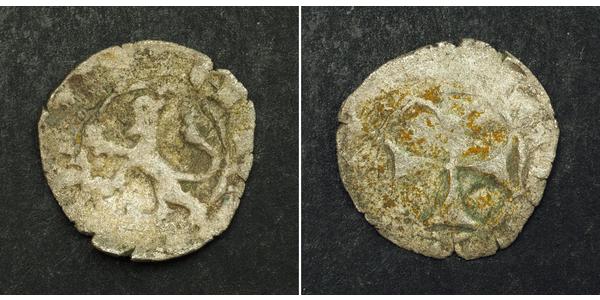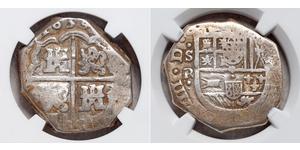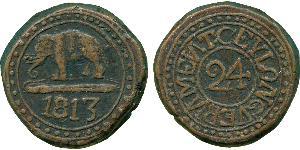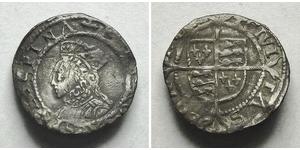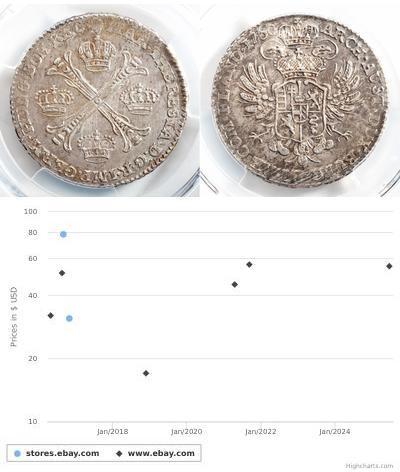(Venduta per $5.0)
Reference: Metcalf 797. Mint Period: 1382-1398 AD Denomination: Denier (Carzia) Ruler: James I (1382-1398 AD) Mint Place: Famagusta (Cyprus) State: Crusader Kingdom of Cyprus Condition: Badly corroded, light deposits, otherwise VG-F! Material: Billon (low grade silver alloy) Diameter: 13mm Weight: 0.38gm
Obverse: Lion rampart left.
Reverse: Cross within inner circle.
The Kingdom of Cyprus was a Crusader kingdom on the island of Cyprus in the high and late Middle Ages, between 1192 and 1489. It was ruled by the French House of Lusignan.
The island was conquered in 1191 by King Richard I of England during the Third Crusade, from Isaac Comnenus, an upstart local governor and self-proclaimed emperor claiming the Byzantine Empire. Richard then sold it to the Knights Templar, who in turn sold it to Guy of Lusignan, jure uxoris King of Jerusalem, in 1192 after the failure of Richard's crusade and when Guy was dispossessed of his late wife's kingdom. His brother and successor, Amalric I of Cyprus, received the royal crown and title from Henry VI, Holy Roman Emperor. A small minority Roman Catholic population of the island was mainly confined to some coastal cities, such as Famagusta, as well as inland Nicosia, the traditional capital. Roman Catholics kept the reins of power and control, while the Greek inhabitants lived in the countryside; this was much the same as the arrangement in the Kingdom of Jerusalem. The independent Eastern Orthodox Church of Cyprus, with its own archbishop and subject to no patriarch, was allowed to remain on the island, but the Latin Church largely displaced it in stature and holding property.
After the death of Amalric of Lusignan, the Kingdom continually passed to a series of young boys who grew up as king. The Ibelin family, which had held much power in Jerusalem prior its downfall, acted as regents during these early years. In 1229 one of the Ibelin regents was forced out of power by Frederick II, Holy Roman Emperor, who brought the struggle between the Guelphs and Ghibellines to the island. Frederick's supporters were defeated in this struggle by 1233, although it lasted longer in the Kingdom of Jerusalem and in the Holy Roman Empire. Frederick's Hohenstaufen descendants continued to rule as kings of Jerusalem until 1268 when Hugh III of Cyprus claimed the title and its territory of Acre for himself upon the death of Conrad III of Jerusalem, thus uniting the two kingdoms. The territory in Palestine was finally lost while Henry II was king in 1291, but the kings of Cyprus continued to claim the title.
Like Jerusalem, Cyprus had a Haute Cour (High Court), although it was less powerful than it had been in Jerusalem. The island was richer and more feudal than Jerusalem, so the king had more personal wealth and could afford to ignore the Haute Cour. The most important vassal family was the multi-branch House of Ibelin. However, the king was often in conflict with the Italian merchants, especially because Cyprus had become the centre of European trade with Africa and Asia after the fall of Acre in 1291.
The kingdom eventually came to be dominated more and more in the 14th century by the Genoese merchants. Cyprus therefore sided with the Avignon Papacy in the Great Schism, in the hope that the French would be able to drive out the Italians. The Mameluks then made the kingdom a tributary state in 1426; the remaining monarchs gradually lost almost all independence, until 1489 when the last Queen, Catherine Cornaro, was forced to sell the island to Venice.
James I (French: Jacques de Lusignan; 1334 – September 9, 1398) was regent of the Kingdom of Cyprus for his infant nephew King Peter II from 1369. When Peter died in 1382, James became King of Cyprus. James was also titular King of Armenian Cilicia and Jerusalem 1382–1398.
James was the third son of Hugh IV of Cyprus and Alix of Ibelin, and became king upon the death of his nephew Peter II. Before becoming a king, he had other offices and was known for his resistance against the Genoese invasion against Cyprus.
After the death of his father Hugh IV, James' half-brother Guy, titular Prince of Galilee was already dead and his eldest brother Peter I, who reigned for 10 years, was then murdered. The latter's son, Peter II, who was a minor, began his reign when he came of age. Meanwhile, Peter I's wife Eleanor of Aragon to revenge her husband's death, invited the Genoese to invade Cyprus.
Since the Genoese had commercial and financial interests in Cyprus, they invaded the island in April 1373. After achieving the takeover of the well-fortified city of Famagusta, they arrested and held captive Peter II and his mother Eleanor who had invited them. After they killed the nobles who had murdered Peter I, they wanted to take control of the island. After the end of the war, Eleanor succeeded the murder of John, which she claimed she was responsible for her husband's murder.
James married his kinswoman Helvis of Brunswick-Grubenhagen (1353 – January 15/25, 1421) (daughter of Philip of Brunswick, Constable of Jerusalem and Helisia of Dampierre) in 1365. Her brother John of Brunswick-Grubenhagen (d. June 11, 1414 unmarried and without issue) was an Admiral of Cyprus and their father Philip of Brunswick-Grubenhagen (ca. 1332 – August 4, 1369/1370) was a Constable of the Kingdom of Jerusalem.
James was created Constable of Cyprus, and in that office, led the war against the Genoese in 1372.
During the invasion, the other two sons of Guy, James and John, resisted the invasion. James fought well in Kyrenia, resisting the Genoese attack, a resistance that was victorious at the end, under the command of James. However, his nephew Peter II, signed a Treaty with Genoese, who kept Famagusta and in the Treaty, James had to leave from Cyprus. James, stopped the war and left the island with a ship from Kyrenia in 1374 and went to Europe. At first he went to Rhodes, where he found no help and he was arrested by Genoese and went in Genoa as a captive with his wife. With the capture of Kyrenia in 1374, he was taken as a hostage to Genoa, where he consummated his marriage with Helvis, whom he had wed when she was twelve. Most or all of their children were born in Genoa. Due to his captivity, he was not crowned until 1385. In Genoa he lived with his wife under hard circumstances for 9 years, and she gave birth to their first son Janus in that city.
After Peter II's death in 1382, since Peter had no surviving issue, the Parliament of Cyprus decided James to be the king, while he was captive in Genoa. Genoese, in order to release him to go to Cyprus to become a king, they negotiated with him and received his signature for agreement on February 2, 1383. Under that agreement, Genoese had new privileges for commercial activities. Famagusta was still under Genoese sovereignty, something that was never accepted by either James and other kings after him and during his reign he tried to regain that city.
Until he was released, the Kingdom of Cyprus was governed by 12 nobles. After he was released in 1383, he was not accepted, as it is referred by the historian Leontios Makhairas and returned to Genoa. Some nobles opposed the return of James, led by the brothers Perotte and Vilmonde de Montolivve, who were believing that with that situation they could become kings. James' opponents could not be beaten, until 1385. In April 1385, James came back again in Cyprus and he went to Nicosia, where he was welcomed with great enthousiasm. He was crowned in May 1385 in Saint Sophia Cathedral by Paul Palaiologos Tagaris. After his crowning, his opponents were arrested and punished.
He was crowned King of Jerusalem in 1389 and in 1393, Leo VI of Armenia died, and James assumed the title of King of Armenia, and was formally given the title in 1396. That kingdom was by now reduced to the city of Korikos, which had been in Cypriote hands since its conquest by Peter I of Cyprus. So when in 1382, Peter II died, James succeeded him, since Peter didn't have a son. He died in Nicosia.

8 Real Vicereame della Nuova Spagna (151 ...
il gruppo ha 17 monete / 15 prezzi
Add coin to this group

